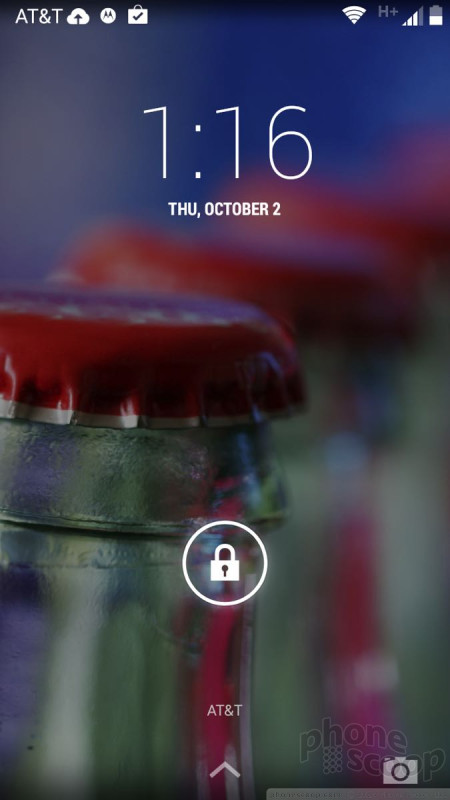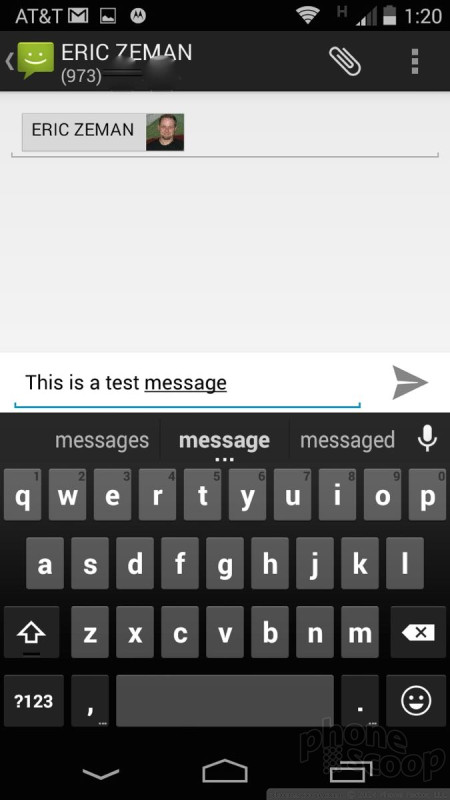Review: Motorola Moto G for AT&T
Menus
The Moto G runs a nearly unmolested version of Android 4.4 KitKat. The software build is closely matched to that of the Moto X, minus a couple big bullet points. The G will be among the first wave of handsets to receive the Android L release, which is expected in just a few short weeks. The phone also comes with a handful of apps developed by Motorola to make the device more useful.
Sadly, the G doesn't have one of the X's best features, which is Active Display. That means the lock screen is a rather static and boring space. It supports the usual set of passwords and other protections, but not the on-again / off-again notifications available to the X. There's one shortcut on the lock screen, and that's to the camera.
The rest of the menus operate exactly as they do on any KitKat phone. There are minimal home screens active out of the box, and they aren't littered with widgets and shortcuts. In other words, it takes only a few moments to customize the panels to suit your own needs. The app menu is laid out in a clean grid. Apps are listed alphabetically, but you can drop them into folders if you want. There's no list view option.
The settings menu offers white text on a black background, which we've seen from Android since 4.0 hit the ground. Motorola hasn't dressed the settings up at all. It is a simple and straight-forward tool for managing the G. Similarly, the notification shade is devoid of extras, like toggles for the radios built into the main screen. Instead, it offers only notifications and access to the Quick Settings with a two-finger swipe.
Motorola stuck with the Qualcomm Snapdragon 400 for the G, the same chipset as last year. I'm a bit disappointed Motorola didn't upgrade the processor at all, but I understand the company is trying to keep the price down. I didn't notice any hiccups in performance while reviewing the phone, though I'd say the G is a bit slower at downloading and installing apps and app updates than the Moto X is. The G compares well, however, to other phones in its own class (many of which are using the same processor).
Calls and Contacts
The phone app is among the default shortcuts pasted into the dock at the bottom of the screen. Pressing the phone button dials up the stock Android phone app. You can swipe sideways to access the call log and your favorite contacts. The call log provides some information about calls (time, duration) in addition to shortcuts for redialing or sending a text message to those numbers.
Contacts are automatically synced with your Google accounts if you use Gmail, but also support ActiveSync, Exchange, and IMAP databases. Contact cards — or direct dial or direct message shortcuts — can be placed on the home screens, which give you instant access to your close contacts. You can also add people to your Favorites list, which is visible in the phone app and includes a homescreen widget. These standard Android calling and contact apps function well enough, though I find they aren't as intuitive as they could be. They perform well on the Moto G.
Messaging
The Moto G comes with the same stock Android communications apps that are on every other Android device. That means Gmail, email, messaging, Hangouts, and Google+. The older messaging app is the default SMS/MMS client when you first boot the Moto G. You can switch the default messaging app to Google Hangouts if you want, but you don't have to. The messaging apps on the Moto G function just as well as they do across the range of Android phones out there. AT&T didn't stick any of its own messaging apps or services on the G.






















 Hands On with the new Moto G
Hands On with the new Moto G
 Cablevision Launching FreeWheel WiFi-Based Phone
Cablevision Launching FreeWheel WiFi-Based Phone
 Motorola Pushing Lollipop to Moto X and Moto G
Motorola Pushing Lollipop to Moto X and Moto G
 Moto G Goes Full-Size
Moto G Goes Full-Size
 Motorola Moto G (GSM, 2nd gen.)
Motorola Moto G (GSM, 2nd gen.)




